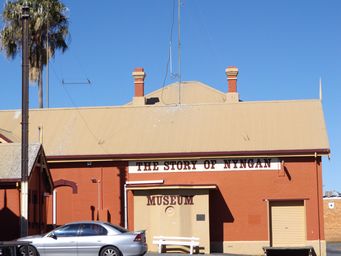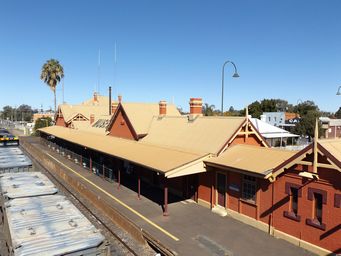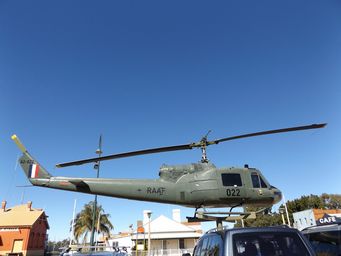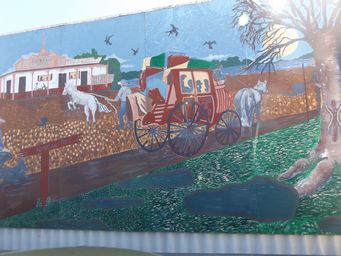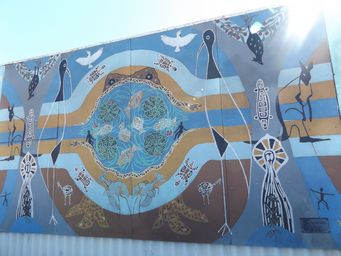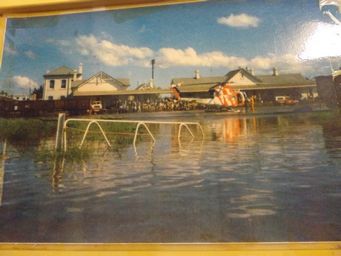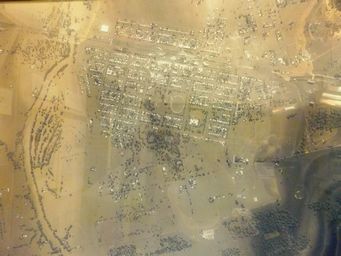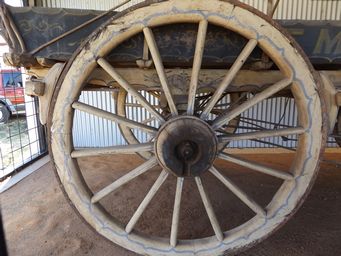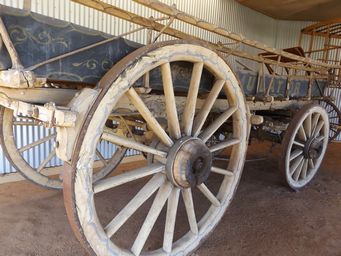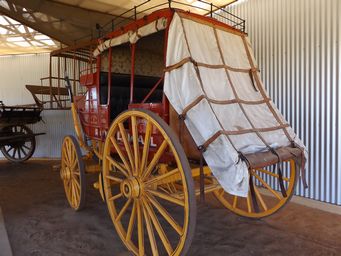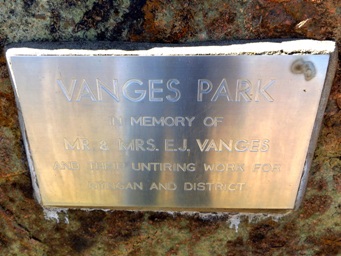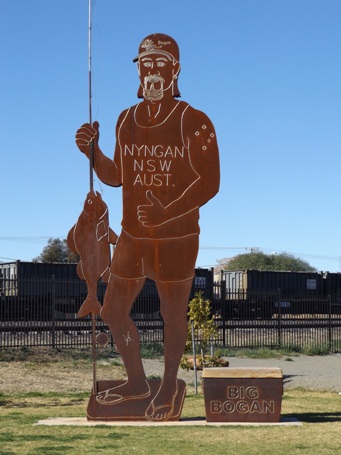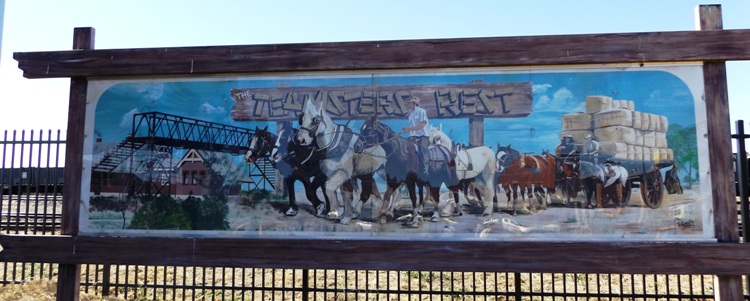
Australia So Much to See
New South Wales - Nyngan, a town of floods and droughts
The Wool Wagon. Cattle were at first grazed in the Nyngan district, but soon Merino sheep were the mainstay. An article in Freemans
Journal dated 1874 states
Adjacent to the Irioquos stands a monument to former Mayor Jack Vanges and his wife for their work for Nyngan.
Volunteers also restored an Iroquois airframe, donated by McDermott Aviation, to replace A2-1022 at Nyngan.
The present
Iroquois stands one metre above the 1990 flood level.
Nyngan Visitor Centre and Museum is in the former railway station building, and is appropriately captioned The Story of Nyngan. The railway line is no longer used for passengers, but remains active for freight trains. The railway branch from Nyngan to
Bourke is now closed, following flood damage in 1989 rendering it uneconomical to repair.
Australia – a land of droughts and flooding rains. No more than at Nyngan does this ring true; a rural shire in an inland region that
had suffered droughts, particularly in recent years. Then there have been floods, with the most damaging and memorable in 1990;
a time which showed the true spirit of a rural community.
One of the largest loads of wool ever seen in Orange arrived from John Brown's Canonbar Run. The load of 50 bales drawn by 14
bullocks left Canonbar on November 25 1874 and arrived in Orange December 23 1874.
Teamsters Rest is conveniently located a short walking distance from the Nyngan Visitor Centre, with adequate parking space for up
to three or more caravans. Once the site of the dump point, that has now been moved to Flood Memorial Park on the other side
of the railways line.
The Big Bogan. Teamsters Rest area now has an additional attraction, based on the connotations
of the shire name of Bogan. A five metre tall image of a man in thongs with fishing rod and esky was created in 2015.
When the town was flooded, people took refuge at the RSL Club, the Palais Theatre, in hotels and motels of two storeys, and at the
hospital.
Some resorted to roofs and ceiling for the night until they were rescued next morning. They went by boat,
or waded holding onto a rope to the safety of the railway Station.
Throughout the day of the 24th April, helicopters airlifted almost the entire population of Nyngan from the Railway Station and Hospital.
Around 2,300 people were flow out to a collection point four kilometres east of Nyngan on the Mitchell Highway. They were then taken to Dubbo by coaches.
Above right shows a helicopter airlifting stranded residents from the railway station platform.
Photo at right is an aerial view of the inundated town in a sea of water. The trees lining the Bogan River define its path through the massive flooded area.
This Iroquois helicopter is on display outside the Nyngan Museum and Visitor Centre.
In 1992, the Governor of New South
Wales and the Nyngan Flood Recovery Coordinator presented Iroquois A2-1022 to the people of Nyngan to commemorate the evacuation of
Nyngan during the 1990 floods. A2-1022 was involved in the most significant Australian action during the Vietnam War, the Battle
of Long Tan.
Iroquois A2-1022 remained in Nyngan for the next 19 years, with most being unaware of its military history. In 2009, a former squadron member traveling through Nyngan spotted the aircraft. In 2011 A2-1022 was transported to the Queensland
Air Museum where it underwent restoration by volunteers. It is now on display outside the Caloundra RSL.
In 1835, Surveyor General Thomas Livingstone Mitchell led a party of men to trace the course of the Bogan River to its junction with
the Darling River, and to map the area for future survey and occupation by settlers, who were already pushing out beyond the surveyed
areas. He described this spot as a 'long pond with many birds, ducks and brolgas' and camped there by the Bogan River. Mitchell
recorded the local Aboriginal word Nyingan, said to mean 'long pond of water'.
The little town of Canonba, 25 kilometres
to the north east on Duck Creek, is part of the history of Nyngan. The Western Railway bypassed Canonba in during 1882/1983, and where
it crossed the Bogan the town of Nyngan grew. The municipality of Nyngan was proclaimed in 1891. The Canonba populace, goods
and public institutions were all moved to Nyngan by 1891. We will visit Canonba next.
Between 19th and 23rd of April 1990 the people of Nyngan filled and stacked over 260,000 sandbags around the town to hold back the
surging floodwaters of the Bogan River.
The flooding which led to the evacuation of Nyngan was caused by two main periods
of rainfall, during 8th to 14th and 18th to 20th of April, with lighter falls 21st and 22nd of April. Flood forecaster underestimated
the peak, and did not predict the surge which breached the sandbag levees.
By the afternoon of 23rd April, with breaches occurring
and being unable to be repaired, sandbagging was abandoned, and waters spread throughout the town.
The peak flood gauge reading
of 5.23 metres was at approximately 2 am on 24th April.
The entire town and surrounds were all under water.
Flood damage was estimated to be as much as $50 million.
Cobb and Co Coach. Cobb and Co serviced the Nyngan area from 1881 to 1888, by which time passengers and freight utilised rail
services. Nyngan's Cobb and Co coach was rebuilt by Nyngan resident Don Burns in 2015 as an accurate replica of the eight seater
coach that used to travel between Bathurst and Bourke (at right).
A restored wool wagon (below) of the type used in the
district is on display together with the Cobb and Co coach at the Teamsters Rest area.
